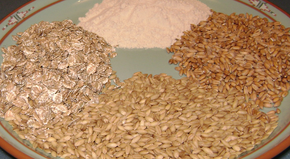Per Wikipedia:
Gluten (from Latin gluten, "glue") is a protein composite found in foods processed from wheat and related grain species, including barley and rye. Gluten gives elasticity to dough, helping it rise and keep its shape and often gives the final product a chewy texture. Gluten may also be found in some cosmetics, hair products, and other dermatological preparations.
Where else will you find gluten?

Sources of gluten in picture- Top: High-gluten wheat flour. Right: European spelt. Bottom: Barley. Left: Rolled rye flakes.
Others: Cereal, bread, pizza, bagels, pastry's, imitation meats (pork, chicken, fish, beef), some pet foods and ice cream.
So in Steph's words: Gluten is a cheap ingredient that can bind things together and adsorb water to make it look larger while adding flavor to make things taste good. No wonder companies want to add this to their foods.
What is the big deal with gluten?
Gluten issues have been around for a while. It used to be that just people with Celiac Disease where known to have issues with gluten but more and more people without Celiac are finding they have issues with gluten.
Celiac Disease is:
- a genetic, inheritable disease.
- Approximately 1 in 133 people have CD, however, only about 3% of these have been diagnosed. This means that there are over 2.1 million undiagnosed people with Celiac disease in the United States.
- characterized by damage to the mucosal lining of the small intestine which is known as villous atrophy.
- responsible for the malabsorption of nutrients resulting in malnutrition.
- linked to skin blisters known as dermatitis herpetiformis (DH).
- not age-dependent. It may become active at any age.
- Celiac Disease can be life threatening
Celiac disease cannot be "caught," but rather the potential for CD may be in the body from birth. Its onset is not confined to a particular age range or gender, although more women are diagnosed than men. It is not known exactly what activates the disease and Celiac disease is life-long and currently incurable. The only known treatment at this time is strict adherence to a gluten-free lifestyle.
Not exactly.
Symptoms of a gluten sensitivity include bloating, abdominal discomfort, pain or diarrhea, or it may present with a variety of other symptoms including headaches and migraines, lethargy and tiredness, attention-deficit disorder and hyperactivity, muscular disturbances as well as bone and joint pain.
Until recently, the terms gluten sensitivity and Celiac disease were used interchangeably in medical literature. However, emerging research indicates that gluten sensitivity has a broader scope than Celiac disease. If the medical history of a patient, along with clinical tests, rule out Celiac disease and wheat allergy, a diagnosis of gluten sensitivity can be considered. However, certain criteria need to be met before a diagnosis of gluten sensitivity can be confirmed.
Treatment for this condition is a gluten-free diet. Prescriptions are typically not necessary since its a sensitivity. Sensitivities can also decrease or cease with time unlike Celiac Disease.
In closing, gluten is a cheap ingredient found in a lot of different foods that is hard for our bodies to digest. Just about everyone I have worked with could benefit from reducing or cutting gluten out of their diets. If you are noticing any of the above symptoms or struggling with weight loss try an 30-90 day elimination of gluten. You might just feel better then you thought possible and its not that hard to do either!
For more info check out my sources and websites I study!
www.lakewinds.com
www.wikipedia.com
www.wsj.com
www.webmd.com
www.gf-blog.com
No comments:
Post a Comment